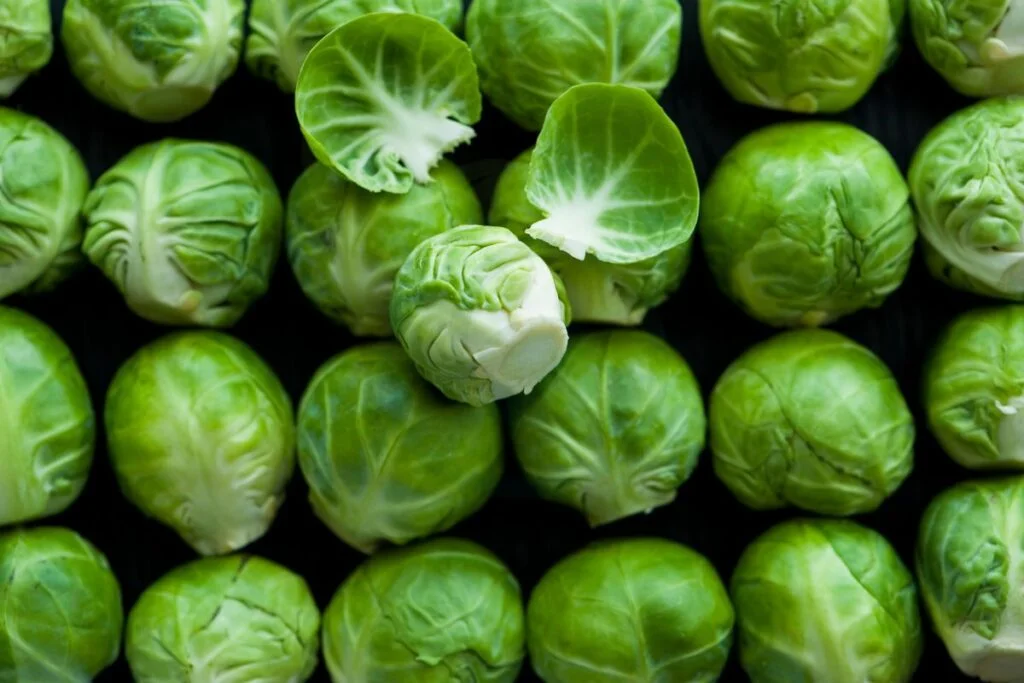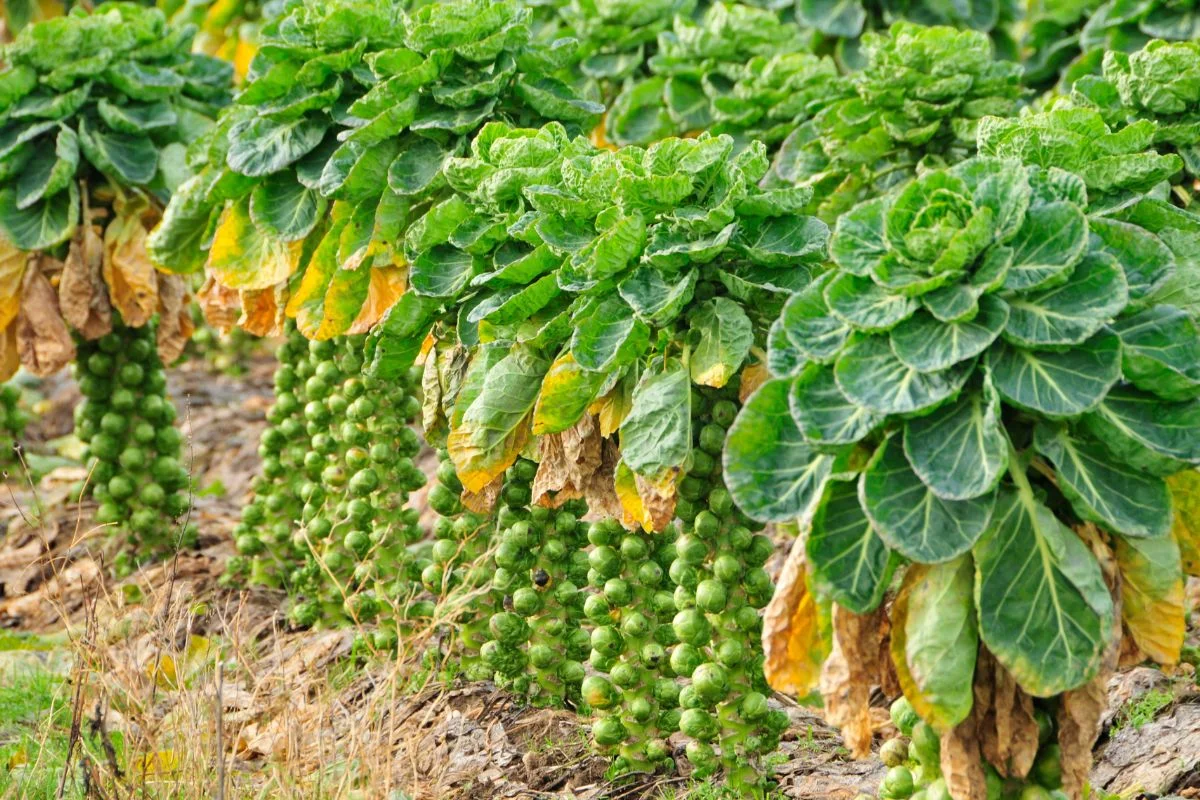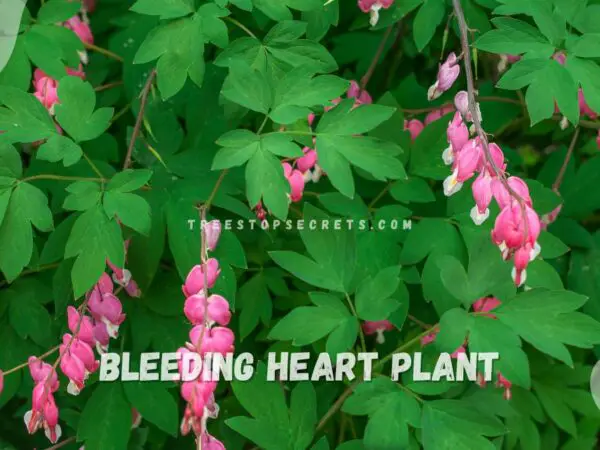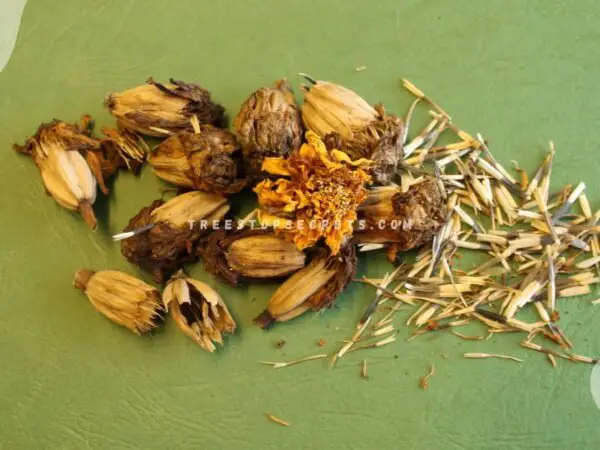Did you know that the spacing between Brussels sprouts can significantly impact their growth and yield? Getting the distance right is crucial for a successful harvest.
When planting Brussels sprouts, ensuring a spacing of 18-24 inches between each plant is ideal. This allows ample room for the plants to develop and receive adequate sunlight and nutrients. Proper spacing promotes good air circulation, reducing the risk of diseases and ensuring healthy growth.
Key Takeaways
- Plant Brussels sprouts approximately 24-36 inches apart in rows that are 36 inches apart to allow ample space for growth and proper air circulation.
- Ensure the soil is well-prepared with compost and has good drainage to support healthy Brussels sprout growth.
- When planting Brussels sprouts, maintain an optimal spacing to prevent overcrowding and promote better development of each plant.
- Regularly water Brussels sprouts, keeping the soil consistently moist but not waterlogged to encourage strong root development.
- Feed your Brussels sprout plants with a balanced fertilizer to provide essential nutrients for robust growth and bountiful harvests.
- Mulch around Brussels sprout plants to retain moisture, suppress weeds, and regulate soil temperature, enhancing overall plant health.
Understanding Brussels Sprouts
Growth Cycle
Brussels sprouts follow a lengthy growth cycle, requiring 80-100 days to reach maturity. From seedling to harvest, they progress through distinct stages. Planning around this cycle is essential for successful cultivation.
Sunlight Needs
Brussels sprouts thrive in full sun exposure for 6-8 hours daily. Adequate sunlight facilitates photosynthesis, promoting healthy growth and robust yields. Insufficient light may hinder growth and reduce the crop's productivity.
Air Circulation
Optimal air circulation is vital for Brussels sprouts' health, preventing diseases and ensuring robust growth. Proper plant spacing enhances airflow around the foliage, reducing the risk of fungal infections and enhancing overall plant vigor.
Soil Preparation
Nutrient Requirements
Brussels sprouts, like other plants, require specific nutrients to thrive. These include nitrogen, phosphorus, and potassium. Providing a balanced fertilizer that contains these essential nutrients is crucial for supporting the growth and development of Brussels sprouts. By meeting their nutrient requirements, you ensure robust plants that yield a bountiful harvest of delicious Brussels sprouts.
Soil Type
The soil type plays a significant role in the successful growth of Brussels sprouts. These plants flourish in well-draining and fertile soil with a pH level ranging between 6.0 and 7.5. Ideally, clay loam or sandy loam soil types are perfect for cultivating Brussels sprouts. The soil type directly impacts the plant's ability to absorb nutrients, grow healthily, and overall plant vigor.
pH Levels
Maintaining the optimal pH levels between 6.0 and 7.5 is crucial for the healthy growth of Brussels sprouts. Monitoring and adjusting the pH levels accordingly ensure that these plants can access vital nutrients present in the soil. Proper pH levels not only support healthy root development but also contribute to the overall vigor of Brussels sprouts, leading to a successful harvest.
Planting Basics
Seed Starting
Indoors
- Starting Brussels sprouts indoors allows for an early planting and extended growing season.
- Better control over germination conditions and seedling growth is achieved indoors.
- Transitioning Brussels sprout seedlings from indoors to outdoors should be gradual.
Outdoors
- Timing outdoor planting of Brussels sprouts according to local climate and frost dates is crucial.
- Select a sunny location with well-draining soil for optimal growth when planting outdoors.
- Monitoring outdoor conditions and providing necessary care are essential for successful cultivation.
Transplanting Seedlings
- Transplanting Brussels sprout seedlings should be done carefully to avoid root damage.
- Proper timing and technique are crucial for successful transplanting of seedlings.
- Adequate watering of newly transplanted seedlings promotes root establishment and reduces transplant shock.
The previous section discussed "Soil Preparation," emphasizing the importance of nutrient-rich soil for healthy plant growth. When starting seeds indoors, ensure they receive sufficient light and warmth for germination. Gradually acclimate seedlings to outdoor conditions before transplanting them into the garden.
Optimal Spacing
Calculating Distance
Determining the correct distance between Brussels sprout plants is crucial for their growth and yield. Spacing them 18-24 inches apart provides enough space for development and air circulation. This ensures that each plant gets adequate sunlight and nutrients.
Using a measuring tape or ruler is essential to maintain consistent spacing when planting Brussels sprouts. Techniques like marking rows and distances help in achieving precise plant arrangements. Accurate measurements play a significant role in promoting uniform growth and effective management of Brussels sprout plants.
Measuring Techniques
Measuring tools such as tape measures are vital for maintaining uniform spacing between Brussels sprout plants. These tools aid in ensuring that the plants are placed at the optimal distance of 18-24 inches apart. By using measuring techniques, gardeners can achieve a well-organized layout that promotes healthy growth.
To measure accurately, start by marking the desired distance between each plant using a measuring tape or ruler. This step helps in creating evenly spaced rows, allowing each Brussels sprout plant to receive ample sunlight and nutrients. Consistent spacing facilitates efficient care and maintenance throughout the growing season.
Watering Practices
Frequency
Water Brussels sprouts regularly to keep the soil consistently moist, especially in dry spells. This helps maintain optimal growth conditions. Fertilize Brussels sprouts at appropriate intervals to ensure a steady supply of nutrients crucial for their development. Regularly check for pests to catch any issues early and prevent infestations.
Amount
Provide the correct amount of water to prevent drought stress or waterlogging, both harmful to Brussels sprouts. Proper fertilization with the right amount of nutrients supports healthy growth. Adjust sunlight exposure based on plant requirements to enhance photosynthesis and overall productivity.
Feeding Your Plants
Fertilizer Types
- Choosing a balanced fertilizer with higher nitrogen content is crucial for optimal growth of Brussels sprouts.
- Organic fertilizers like compost or manure are excellent choices, providing slow-release nutrients for sustained development.
- Selecting the right fertilizer type based on the specific needs of your plants ensures healthy and productive Brussels sprout growth.
Application Schedule
- Following a consistent fertilization schedule throughout the growing season is essential for steady development in Brussels sprouts.
- Applying fertilizers during specific growth stages, such as after transplanting or before flowering, can significantly enhance plant growth.
- Adhering to an application schedule helps prevent nutrient deficiencies and supports overall plant health in Brussels sprouts.
Mulching and Weeding
Mulch Benefits
Mulching around Brussels sprout plants helps with soil moisture retention and weed growth suppression. Organic mulches like straw or grass clippings decompose, providing nutrients. These benefits include regulating soil temperature, reducing erosion, and improving overall soil health.
- Mulching retains soil moisture
- Organic mulches decompose for added nutrients
- Regulates soil temperature and improves soil health
Weed Control
Regular weeding is crucial to prevent nutrient and water competition among Brussels sprout plants. Using landscape fabric or mulching helps suppress weeds, maintaining a clean growing environment. Effective weed control reduces pest habitat and promotes healthy growth.
- Regular weeding prevents nutrient competition
- Landscape fabric suppresses weed growth
- Effective weed control promotes healthy plant growth
Pest Management

Cabbage Worms
Cabbage worms are common pests that feed on Brussels sprout leaves, causing significant damage to the plants. Monitoring for cabbage worms and their eggs is crucial to detect infestations early. By spotting them promptly, you can intervene in a timely manner to prevent widespread damage. Natural predators like parasitic wasps play a vital role in controlling cabbage worm populations specifically in Brussels sprouts.
Common Pests
Aphids, flea beetles, and caterpillars are among the common pests that can negatively impact Brussels sprout plants. To combat these pests effectively, implementing pest management strategies such as handpicking, using insecticidal soap, or neem oil is essential. These methods help in controlling pest populations without harming the plants. Regular inspection of your Brussels sprouts is key to early detection, preventing pest damage, and ensuring healthy growth for your plants.
Harvesting Tips
When to Harvest
Brussels sprouts reach their peak readiness for harvest when the buds are firm, green, and around 1-2 inches in size. Starting from the bottom of the stalk during harvesting allows the top buds to mature further. This sequential approach ensures a continuous supply of fresh Brussels sprouts.
Storage Methods
To extend the freshness of harvested Brussels sprouts, it is recommended to store them in the refrigerator. Freezing after blanching is an effective method to preserve their nutritional content for extended periods. By utilizing airtight containers or freezer bags, you can maintain the quality and flavor of Brussels sprouts over time.
Final Remarks
Now that you have a solid grasp on planting and caring for Brussels sprouts, you are well on your way to a bountiful harvest. Remember the importance of proper spacing, watering, feeding, and pest management to ensure healthy growth. By following these guidelines, you are setting yourself up for success in cultivating delicious Brussels sprouts right in your backyard.
Take the knowledge you've gained here and put it into action. Get your hands dirty, tend to your plants diligently, and watch as your Brussels sprouts thrive. Share your newfound expertise with fellow gardening enthusiasts and continue to expand your skills. Happy planting!
Frequently Asked Questions
How far apart should I plant Brussels sprouts for optimal growth?
To ensure healthy growth, plant Brussels sprouts 18-24 inches apart in rows spaced 2-3 feet apart. This spacing allows ample room for the plants to develop and receive adequate sunlight and nutrients.
Should I mulch around Brussels sprouts plants?
Yes, mulching around Brussels sprouts helps retain soil moisture, suppresses weeds, and maintains a consistent soil temperature. Organic mulches like straw or compost can be beneficial in providing nutrients as they break down over time.
When is the best time to harvest Brussels sprouts?
Brussels sprouts are ready for harvest when the buds are firm, about 1-2 inches in diameter, and have a vibrant green color. Start harvesting from the bottom of the stalk upwards as the lower sprouts mature first.
How often should I water my Brussels sprout plants?
Water consistently to keep the soil evenly moist but not waterlogged. Depending on weather conditions, aim to provide about 1-1.5 inches of water per week. Adjust watering frequency during dry spells or excessive rainfall.
What common pests should I watch out for when growing Brussels sprouts?
Keep an eye out for cabbage worms, aphids, and caterpillars that can damage Brussels sprout plants. Implement pest management strategies like hand-picking pests, using row covers, or applying organic insecticidal soap as needed.
Image Source: Paid image from CANVA




